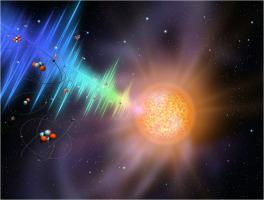Lithium evolution in the low-mass evolved stars with asteroseismology and LAMOST spectroscopy
IF 6.3
3区 综合性期刊
Q1 Multidisciplinary
引用次数: 0
Abstract
Lithium is an ancient element that was first produced by the Big Bang Nucleosynthesis (BBN) a few minutes after the birth of the Universe. Lithium is a sensitive tracer for a number of processes in a variety of astrophysical environments due to its multi-channels of production and fragility. These features also make lithium a complex element at the center of many unsolved problems. The behavior of lithium in the low-mass evolved stars is one such issue. It is known that such stars not only destroy but also produce lithium, while neither the destruction details nor the production mechanisms over different evolutionary phases are clear. In this paper, we summarize the recent results obtained from the studies combining large-scale spectroscopic surveys, asteroseismology, and traditional high-resolution spectroscopy. We present the detailed evolution behaviors from the red giant branch (RGB) to the red clump (RC) phase characterized by the core helium-burning in the stellar interior. We show the new signatures discovered from the recent studies for the lithium-enhanced giants and also discuss various observational and theoretical constraints on lithium production in red clump stars.

用星震学和LAMOST光谱研究低质量演化恒星中的锂演化
锂是一种古老的元素,在宇宙诞生几分钟后由大爆炸核合成(BBN)首次产生。锂是一种敏感的示踪剂,用于各种天体物理环境中的许多过程,由于其多通道的生产和脆弱性。这些特点也使锂成为许多未解决问题的中心的复杂元素。锂在低质量演化恒星中的行为就是这样一个问题。众所周知,这类恒星不仅会破坏锂,还会产生锂,但在不同演化阶段的破坏细节和产生机制都不清楚。本文综述了近年来大尺度光谱学、星震学和传统高分辨率光谱学相结合的研究成果。我们详细描述了恒星内部从红巨星分支(RGB)到以核心氦燃烧为特征的红团(RC)阶段的演化行为。我们展示了最近研究中发现的锂增强巨星的新特征,并讨论了红团星中锂生产的各种观测和理论限制。
本文章由计算机程序翻译,如有差异,请以英文原文为准。
求助全文
约1分钟内获得全文
求助全文
来源期刊

Fundamental Research
Multidisciplinary-Multidisciplinary
CiteScore
4.00
自引率
1.60%
发文量
294
审稿时长
79 days
期刊介绍:
 求助内容:
求助内容: 应助结果提醒方式:
应助结果提醒方式:


